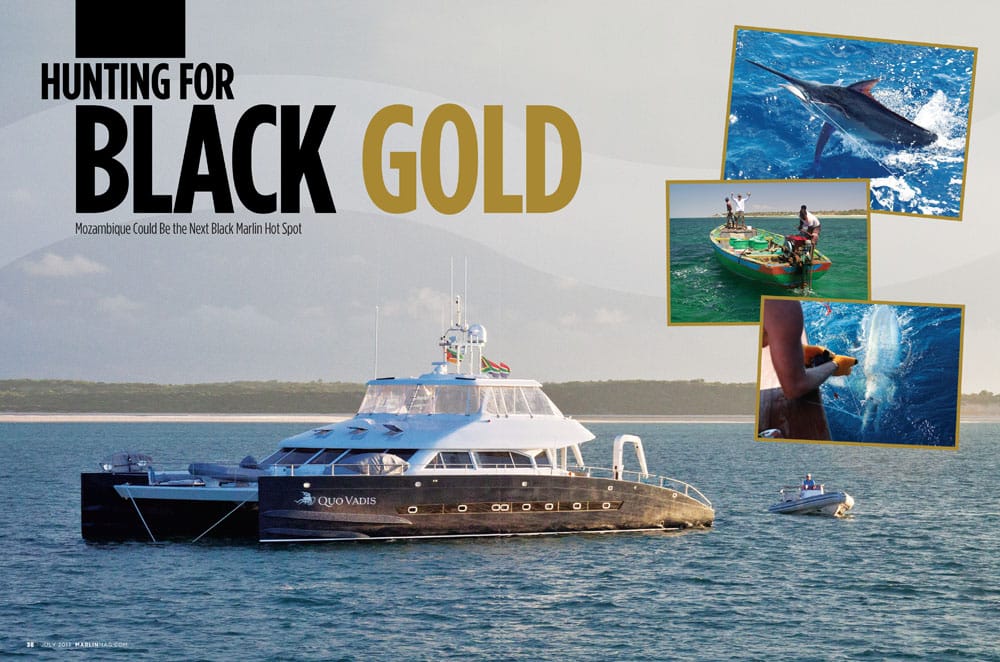
While fishing in Ascension Island, my good mate Kevin Hodgson from Cape Town, South Africa, started telling me about his plans for building an “expedition” yacht to explore some of the untouched coastline of Africa. He’d already started building the boat, a 75-foot oceangoing Power Cat named Quo Vadis, which is Latin for “where to from here,” with his partner and longtime friend, Mark Delany, a second-generation owner of Two Oceans Marine out of Cape Town.
At that time, the plan was to carry along a 25-foot catamaran or center-console ski boat to launch from the mothership and fish with. Since most South Africans fish in these boats, it made a little sense, but Hodgson soon saw the need for something a bit more substantial to fish from, so he included a 48-foot custom game boat named Big Bob in the excursion’s plans.
When he asked if I wanted to captain Big Bob for the 90-day trip, I was all in. Having been fortunate to chase giant marlin in most of the world’s hot spots, the Indian Ocean, in my mind, represents fishing’s last frontier. I’d only fished a few days in the Indian Ocean, and having a shot at a grander was all the motivation I needed.
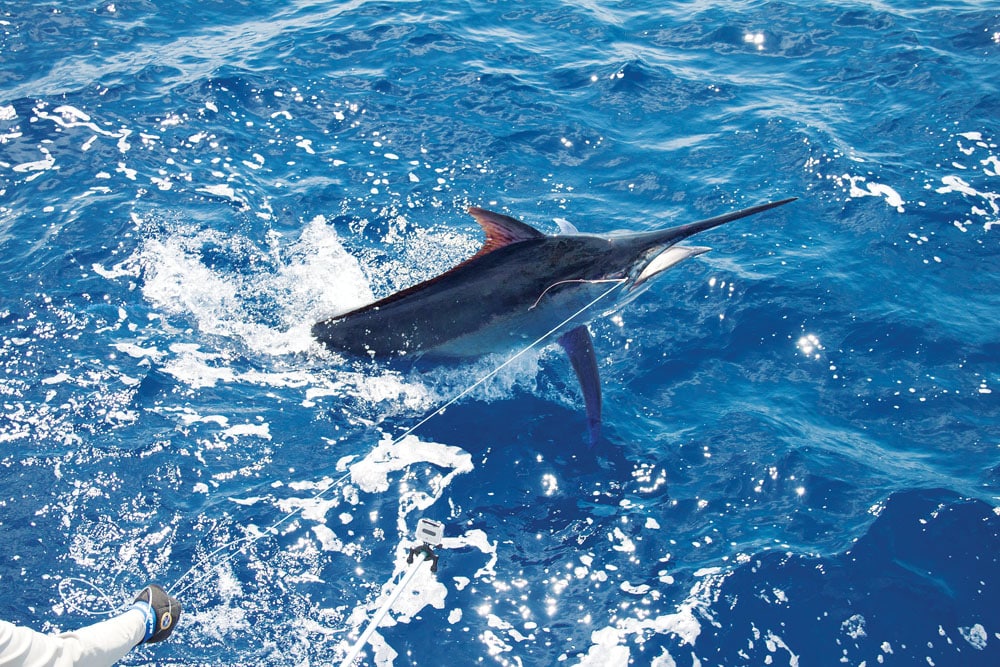
While the two boats were being constructed in the factory, Hodgson told me of his plans to travel 1,200 miles up the coast into the Indian Ocean and fish the Bazaruto Archipelago in Mozambique. The location, infrastructure and other logistics make Bazaruto a difficult place to get your boat to for any serious marlin fishing. So the goal of the trip was to give a serious effort with the right equipment in order to assess the viability of the black-marlin fishery.
Hodgson grew up fishing the wild coasts of Africa with his father, Graham “Big Bob” Hodgson, mostly chasing the numerous varieties of inshore game fish from Cape Point up the Indian Ocean all the way through Mozambique. As with most hungry fishermen, Hodgson wanted bigger game, so he eventually began chasing big yellowfin tuna in the exceptionally rich tuna waters off Cape Point. But when he caught his first marlin off a ski boat while surf launching out of Cape Vidal near the Mozambican border, the seed was planted.
In 2011, the two of us took a trip there to assess the possibility of making the adventure happen. Bazaruto is the main island of the four that make up the archipelago. The islands are mainly big sand dunes surrounded by turquoise lagoons and spits that complement the beauty of the warm Indian Ocean. The strong Mozambican current that runs north to south through the channel between the African continent and Madagascar pushes an abundance of marine species directly into the Bazaruto Archipelago and the reefs that lie in and around it.
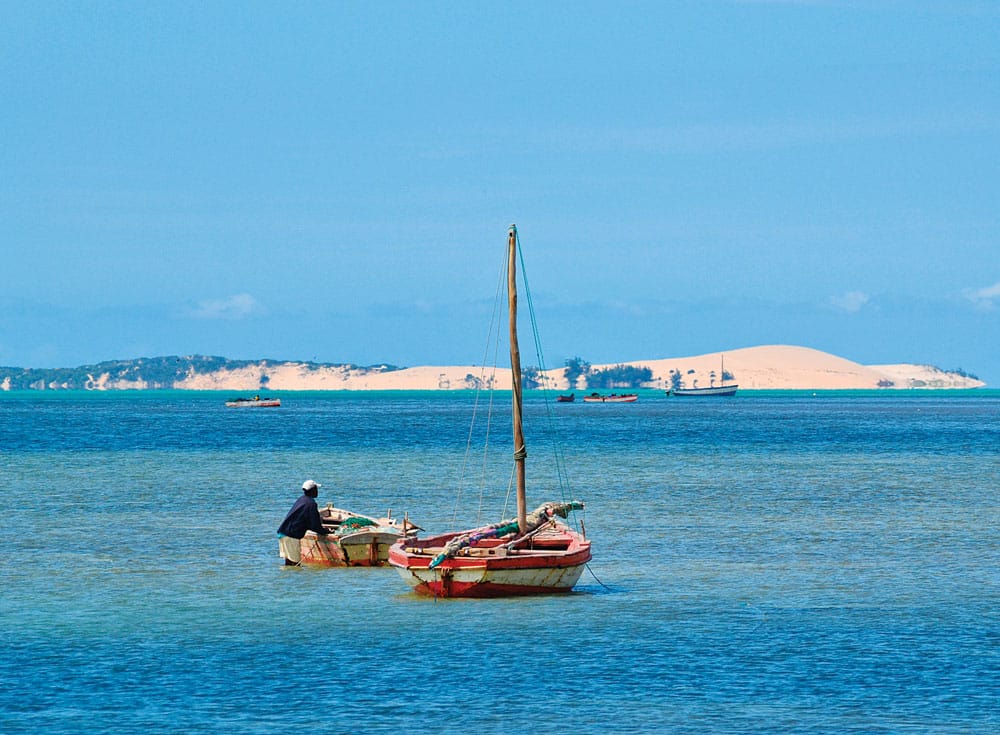
Game-Fish History
Mozambique has a short but rich sport-fishing history. In the “early days,” from the late ’50s until the mid-’70s, before the nation’s civil war changed everything, a small group of South Africans and local Mozambicans fished the waters off Bazaruto, discovering a black-marlin fishery that rivaled that of the Great Barrier Reef in Australia.
Accurate statistics from those years are hard to find, but in talking to locals and looking at logs from the lodges, the boys in the prewar era weighed in at least six, and as many as 12, granders. The war shut the country down until the mid-’90s, but once it stabilized, adventurous fishermen started to return.
Even though there are only a handful of small boats fishing each season, with most of the emphasis put on inshore game species or vertical jigging, Bazaruto once again provided a world-class marlin fishery for those who could get there. In 1998, a South African by the name of Johnny Harel broke the all-African marlin record with a 1,298-pound black. He caught the fish out of a 25-foot reef runner off the top of Bazaruto Island on a lure. Since that time, at least one lucky angler has caught a marlin in the 1,000-pound class every year, with several officially weighed.
Duarte Rato, a local skipper out of Indigo Bay Resort, probably has put in the most time chasing marlin out of Bazaruto over the last 12 years. He also has been fishing in Madeira for several years now alongside Capt. Peter Bristow, and has seen the big fish of the Azores as well. I got to know Rato quite well, and respect his opinion as well as the effort he puts into keeping Bazaruto on the sport-fishing map. He was eager to help me wherever I needed it, and, being a local from Vilanculos, he has a wealth of knowledge.
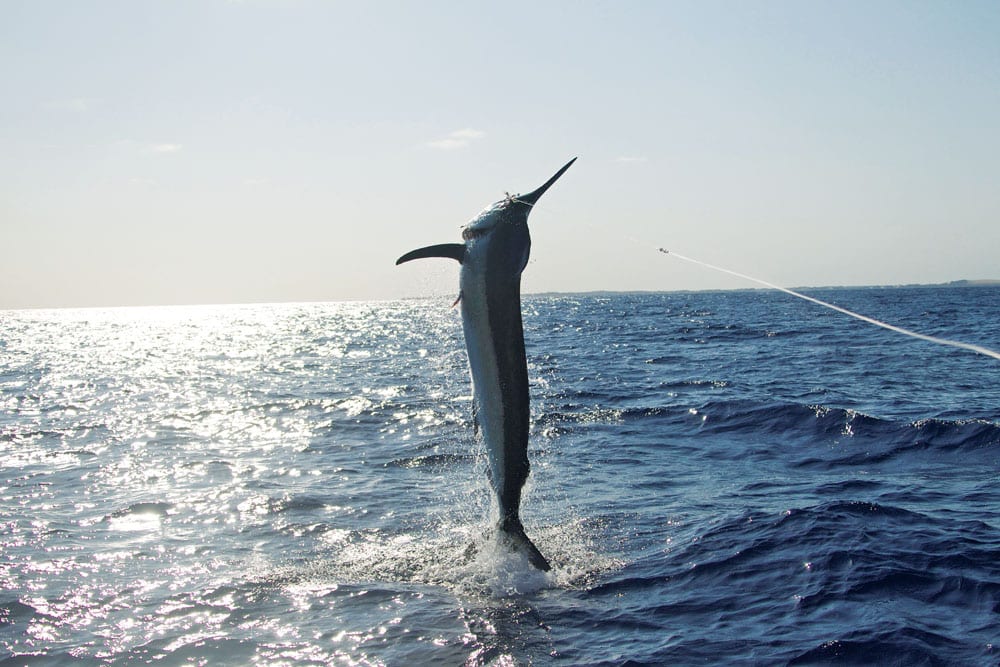
Over lunch one day during a blowout, I asked Rato about his experiences fishing Bazaruto in the last decade, and he told me about the 1,107-pounder he weighed in 2008. I’d seen the photos and remembered several big chunks missing due to sharks. He said the measurements they took from the fish calculated out to 1,413 pounds using the standard formula. Rato weighed a 1,098-pounder on Vamizi since then, and said he’s released several others in that class.
The Place
We planned to have the boats in Vilanculos by mid-September and fish through mid-December. Vilanculos, on the mainland, would be our base for transfers, provisioning and fueling and our home for 90 days. Hodgson planned on being in and out for 50 of those days, filling in the rest with friends and family.
The boats splashed in August, and after sea trials, they set sail for Vilanculos via a stop in Durban. On Sept. 15, we flew in over the stunning archipelago at the same time the boats were making the turn into the cut between the islands of Bazaruto and Benguerra. After a low “buzz” over Quo Vadis, we touched down in Vilanculos and got a ride to the beach to meet the boats and the rest of the crew. I spent the next week doing a lot of organization and familiarizing myself with the boat and, more importantly, the charts.
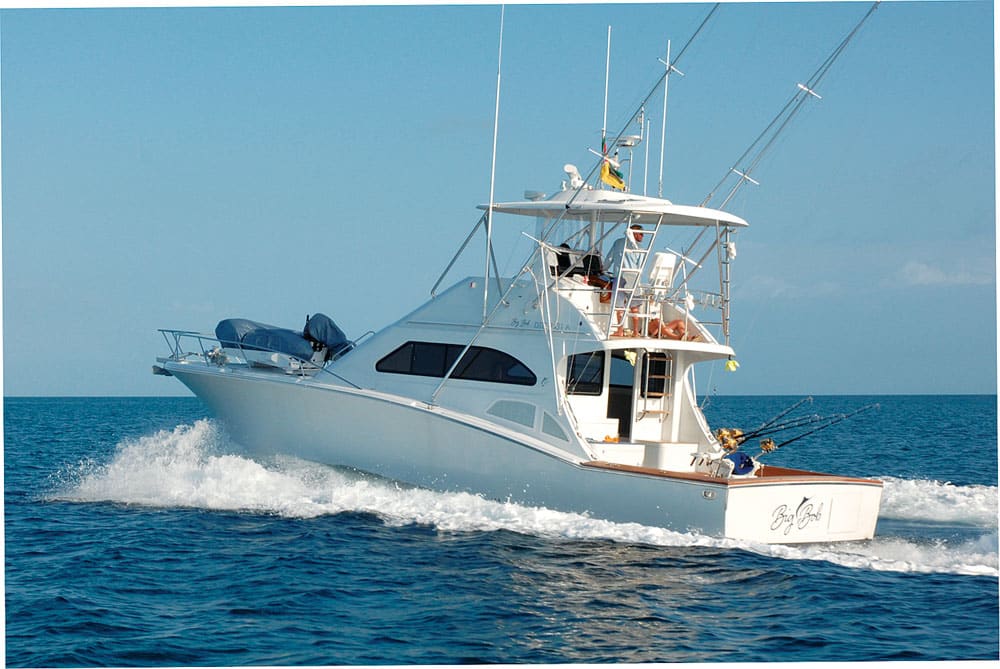
The Bazaruto Archipelago is a unique area. It is mainly made up of sand, and with the tides running up to 12 feet, the channels and spits constantly change. The correct tides and currents were critical to moving the boats around the islands and to and from anchorages. All the information that we got from locals (who were running around in small ski boats with no draft) we had to take with an “eyes wide open” approach for the first several weeks. Certain anchorages experienced such forceful tidal flows that if you fell in, you wouldn’t make it back to the boat. Some cuts you could only go through during a three- or four-hour window. I had never experienced any place in all my travels where my every move was directly governed by the tides.
The Numbers
We started fishing around Sept. 20, and from the start, the conditions were never really good; in fact, at times they were terrible. For the first several weeks, the water temperature never got above 75 degrees F, with green water everywhere and a conspicuous lack of bait. We still plugged it out every day, mainly trolling lures to search around and look for better water, but it wasn’t anywhere to be found, and the satellite link confirmed what we were seeing.
We would catch the odd marlin here and there, but the lack of conditions for good fishing began to take its toll. Rato kept us positive, repeatedly telling us that these wintertime conditions would roll over soon, so we kept fishing and waiting. Unfortunately, cold fronts kept rolling off the cape down south, and it looked like the weather would never change. We continued to see only a few fish each week. When you add the bad weather with the fact that we were entirely self-sufficient, with tricky anchorages and a very challenging infrastructure, it made for long, stressful days.
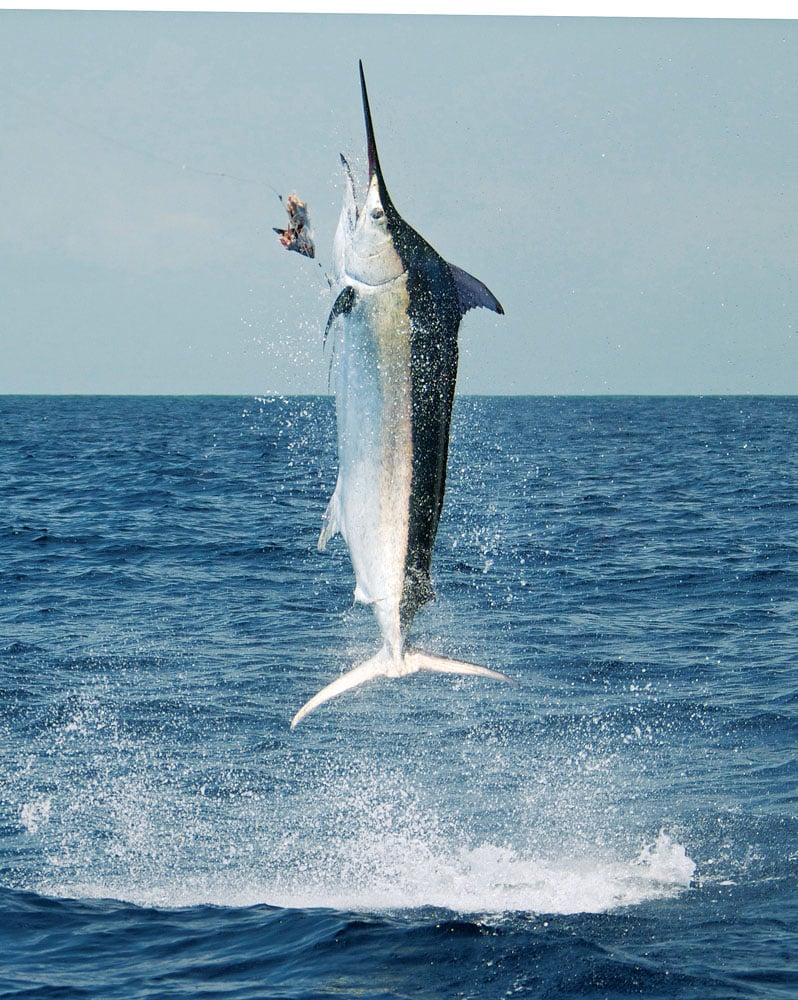
Even getting fuel proved an interesting exercise. A fuel run entailed a ride to the local petrol station, where we chaperoned the filling of 1,000 liters of diesel at a time into barrels on a trailer; then we towed the trailer two miles to the beach with a tractor, gravity fed it into drums in a dhow (an African panga), and transferred it on anchor from the dhow to the boat via a 24-volt pump. We then repeated the process. “Once the fish come, it will all be worth it,” I kept muttering to myself.
Near the end of October, we got a decent weather window, and Hodgson had a bunch of his hard-fishing South African buddies with him, so we planned a trip out to Bassas da India. Bassas is an atoll 240 miles due east out into the Indian Ocean that creates a beautiful six-mile-wide oasis. It looked unbelievable on the chart, so we left for the long trip out there. The day we arrived, the bite was on! We saw a few blues, catching one at least 600 pounds, as well as sails, spearfish and yellowfin tuna, all a couple of hours before dark. The next day, we couldn’t wait to get back out, and half of us went in search of marlin while the other half stayed to fish the reef, which was a natural aquarium full of untouched life.
Amazingly, we couldn’t find a bite off the edge, though the guys who stayed on the reef caught everything else imaginable!
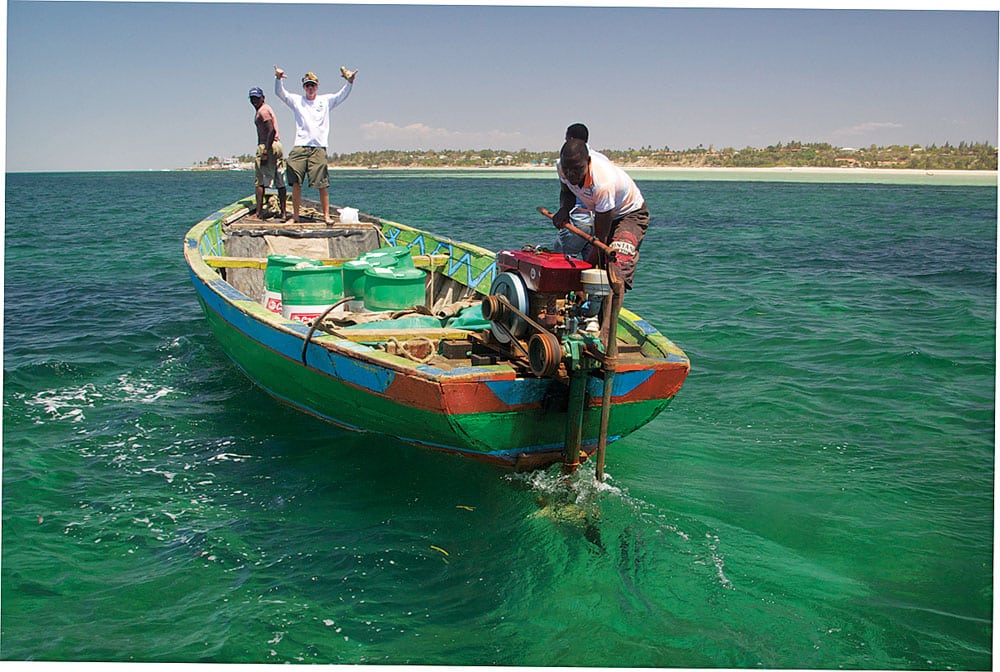
The next day, a 30-knot southerly blew in and we had to ride it 240 miles back to Bazaruto. I chalked it up to one more dues payment.
We had a few days off once we got back to the mainland while waiting on the big southerly to blow itself out, but I remembered Rato saying that the blow would push the warm blue water of the Indian Ocean up against the archipelago. That blow became the turning point of the season.
We headed down south a ways to a big canyon shown on the charts with our angler, “the Don,” for the next trip. Surprisingly, I found myself riding through blue, 80-degree water. We caught two small blacks right away on our lures, so I decided to put out the skipbaits. About an hour later, there she was: a nice big girl on the right skipbait. I’d never been so happy to see an 800-pounder! We released her after a 25-minute fight on a 20/0 Mustad circle hook and went back to the anchorage behind Margaruque that night. I must say that the rum flowed quite nicely. The rest of that trip went well; we caught a few nice ones and saw several more.

Conditions improved continuously, and we saw fish nearly every day. With 30 or so days to go in the season, we still had plenty of time to catch them up.
We spent our mornings catching fresh baits. We caught kawa-kawas and yellowfin for our skipbaits, and big, beautiful queenies and runners for our swimbaits. I now got the distinct feeling that I was fishing off Cairns, except that I hadn’t seen a boat other than Vamizi for weeks.
The first day of our next trip, we saw six blacks and caught two — they were finally here! Unfortunately, their arrival coincided with our own rubber-hook week. Over the next few days, we saw double-digits of fish, catching only a few.
One day, after going 1 for 3 on dead baits, just before dark a really big black showed up on the “gray ghost” (a tuna that’s lost all its color), but after it took an impressive bite and one big jump, I saw both the tuna and the circle hook go flying. She was probably the biggest one we saw the entire season.
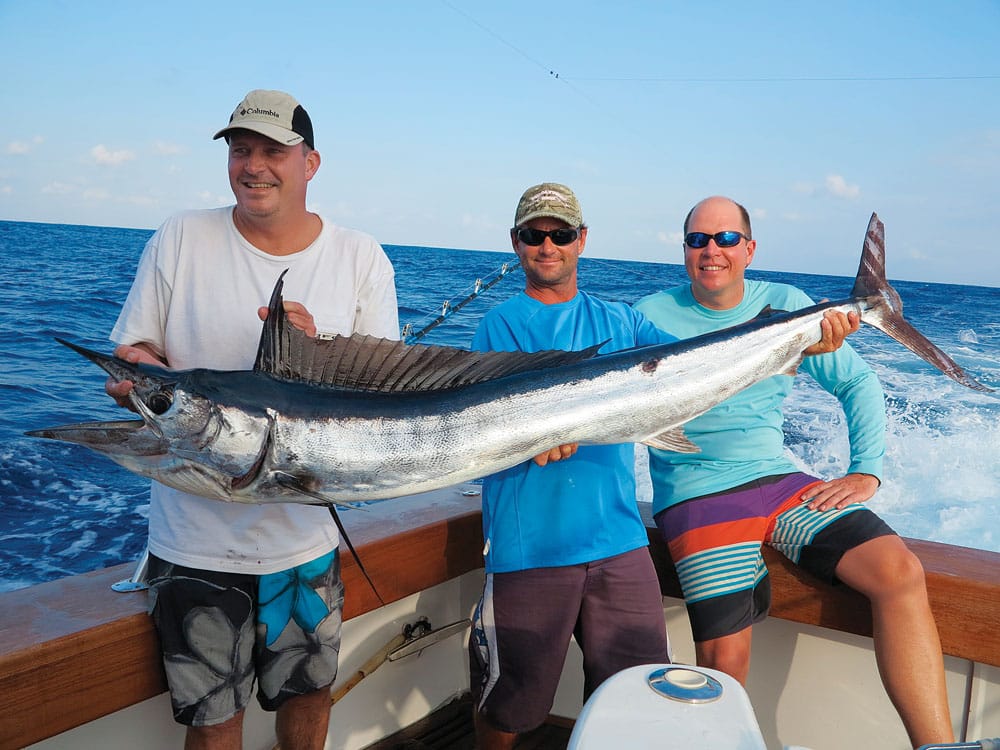
Hodgson came back to finish out the next 20 or so days on and off with his mates. Over the last three weeks, we saw fish nearly every day, and raised as many as six on some days. The hooks started setting as well. We caught three several days, with most of the fish weighing 400-plus pounds. I was really surprised at the quality of the fish we saw. I can count the rats we caught, but it is much harder to count the 500-pounders.
Hodgson ended up catching two fish north of 800, and one of his friends caught one in that vicinity that never jumped, so it was hard to call. We were having so much fun that Hodgson got some lessons driving on the fish as well as switching off on the leader with Chris “Spanky” Pike, my greenhorn crew member who really pulled his weight. Spanky learned all of the bait rigging and wiring skills quite fast.
Before our last fishing day, I had seen enough big fish to want to sign up again for next year. I believe that the biggest ones we saw we pulled hook on as well. The last week, Hodgson and I were already planning the 2013 season while we were fishing, and we loved it. If you want the numbers, the last five weeks we saw two to three fish per day, catching just shy of a fish per day, with the average fish above 400 pounds and with several over 800. All the effort and time paid off in the end.
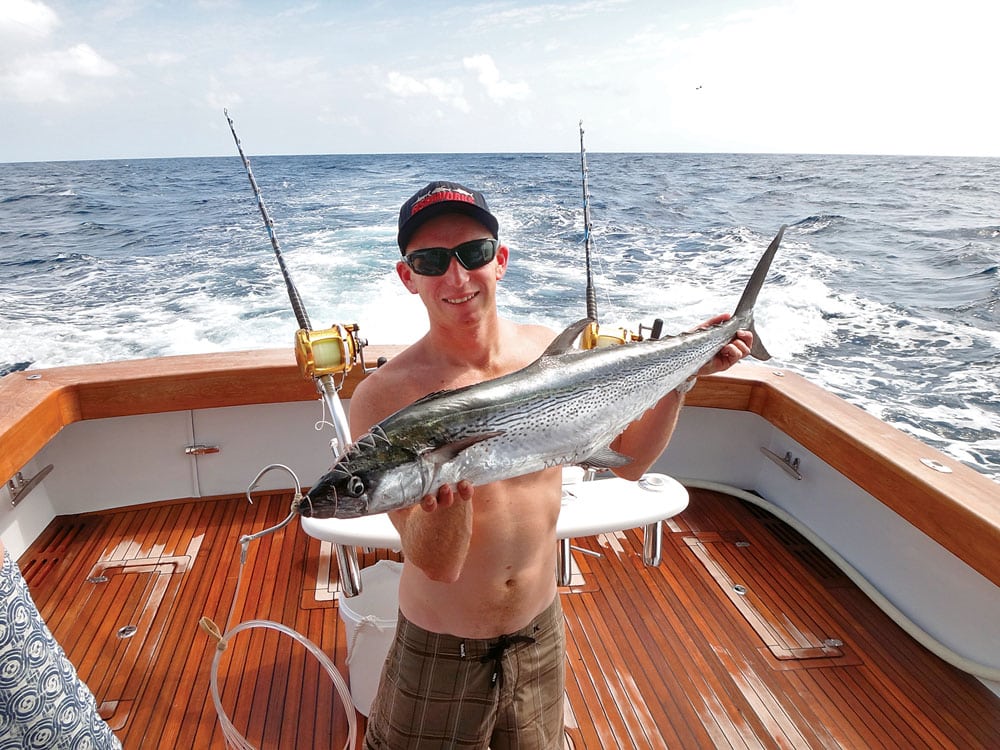
I have to assume after what I saw (and what Rato has seen in his years in Bazaruto) that this was just one of those late years. The longer I do this, the harder it seems to predict the fishing seasons.
Rato says that when he starts in September every year, the fish are usually there. The fishing I saw during the last five weeks there was world class; if a normal year offered that kind of fishing for the duration, it would be epic.
All said and done, I feel that Bazaruto offers an exciting place to chase giant black marlin in a truly exotic and untouched locale. In this day and age, there is something to be said for trolling your baits all day and not seeing another boat. I felt most days that we had stepped back in time, but were able to take today’s amenities with us to get the job done. One thing is for sure: I will be back there again next year to sample whatever Bazaruto has to offer. My fingers are crossed for that four-digit fish of a lifetime for Hodgson, as thanks for making this dream a reality.







